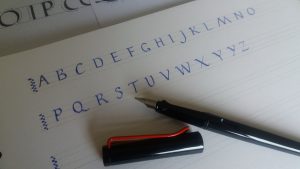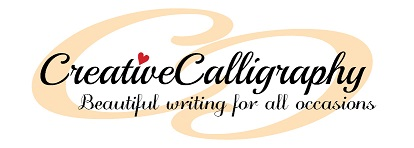Getting started with calligraphy
Calligraphy is a fairly inexpensive hobby to get into.
All you really need is a pen and a piece of paper to get you started!
The type of pen you need depends on the type of calligraphy you want to start learning.
 Most calligraphers start with the foundational, or Roman round hand, script.
Most calligraphers start with the foundational, or Roman round hand, script.
It’s certainly what I introduce people to first in my workshops for the Cultural Spring in South Tyneside.
A broad edged pen is what you would need for that and many other traditional calligraphy scripts.
You can then decide if you would prefer to use a cartridge pen, or dip pen and ink.
The Lamy Joy from The Pen Shop is a lovely, quality pen and comes in a range of nib widths.
I would suggest the 1.5mm to get you started.
You can also buy the gift set featuring all three nibs, which would be a sound investment.
The Coles Calligraphy range would be for you if you are comfortable with pen and ink.
 A variety of nibs can be fitted to a straight or oblique holder.
A variety of nibs can be fitted to a straight or oblique holder.
Some will need a reservoir to hold ink, while others, such as pointed nibs, do not require one.
Pointed nibs are used for copperplate and modern calligraphy styles, where pressure, rather than pen angle, creates the thick and thin strokes.
Loose sheets of good quality cartridge paper are good for practising on, but you may want to use a notebook of some kind so you can keep track of your progress.
Just make sure the paper is not too thin, as the ink will bleed.
A pencil, ruler and eraser are also essential parts of a calligrapher’s kit, for marking out guidelines.
Lettering height is dictated by the style of calligraphy and width of the nib you are using.
 There are many calligraphy books available and you may be able to find some in your local library.
There are many calligraphy books available and you may be able to find some in your local library.
The best seller on Amazon at the time of writing this was The Calligrapher’s Bible: 100 Complete Alphabets and How to Draw Them, by David Harris.
I have just invested in a copy of Modern Calligraphy by Molly Suber Thorpe after it was recommended to me by another calligrapher.
There are also countless tutorials and downloadable worksheets available online.
Scribblers is a great starting point.
But I think the best thing you can do is find a workshop near you for personalised tuition and peer mentoring.
The Calligraphy Lettering and Arts Society website also has an interactive map of tutors and groups.
This blog was originally written for The Pen Shop.
